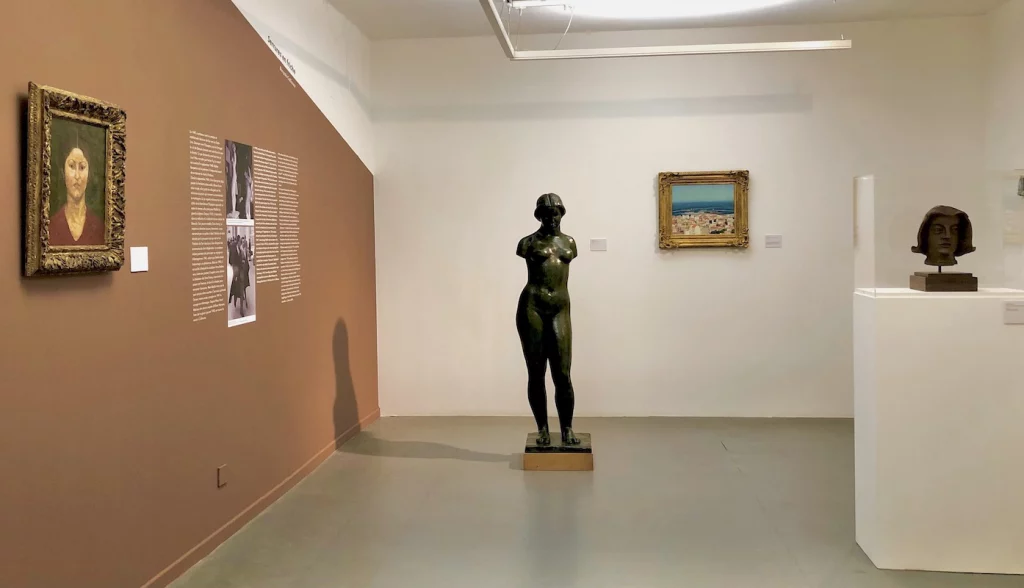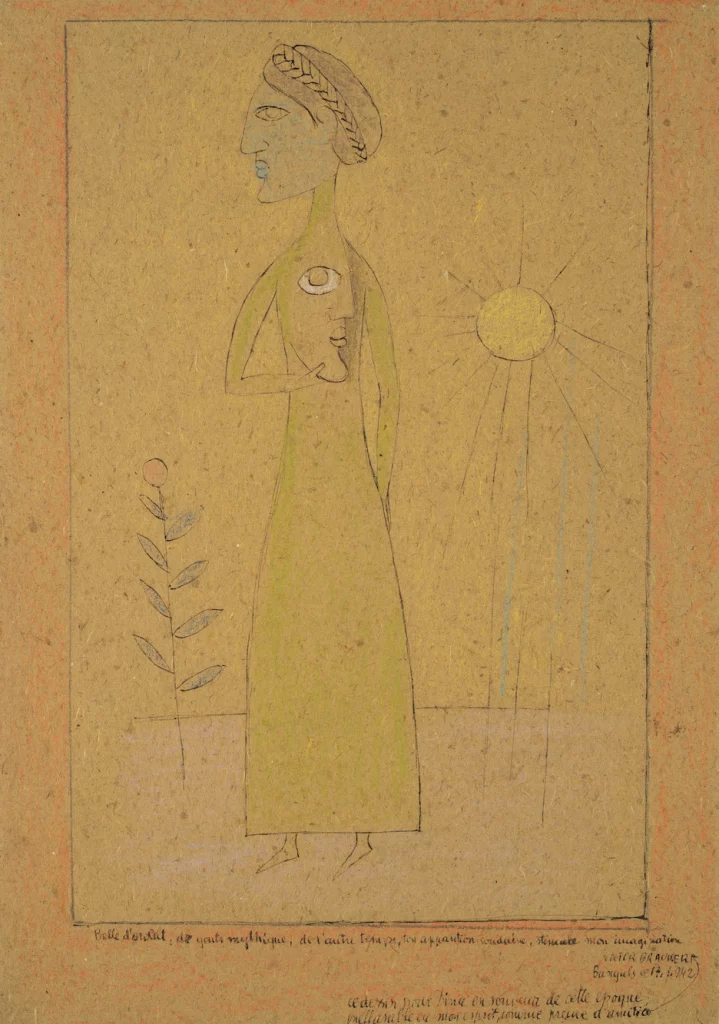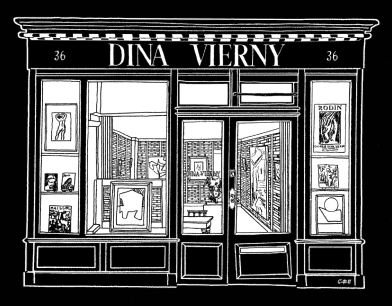All Exhibitions here
From 3 June to 8 October 2023, the Musée d'Art Moderne in Collioure is dedicating an exhibition to the artists who lived in the Pyrénées-Orientales during the Second World War. "Harmonie" by Aristide Maillol and other portraits of Dina Vierny by Maillol and Victor Brauner are presented in this event entitled Front de mer, Canet-Collioure-Banyuls 1940.September 9, 2023
 View of the "Front de mer" exhibition at the Musée d'Art Moderne de Collioure from 3 June to 8 October 2023 © Musée d'Art Moderne de Collioure
View of the "Front de mer" exhibition at the Musée d'Art Moderne de Collioure from 3 June to 8 October 2023 © Musée d'Art Moderne de Collioure From 1940 onwards, many artists were forced into exile for religious, political or ideological reasons. The Pyrénées-Orientales, close to the border with Spain, became a transit point for many refugees fleeing the Nazi regime and wishing to emigrate to the United States. Many artists, writers, intellectuals and people persecuted by authoritarian regimes passed through this southern border, and Banyuls in particular, to find refuge in America. Collioure, Banyuls-sur-Mer and Canet were important places for the Surrealists during the Occupation. The Villa Le Crépuscule (or Le Crépuscule de la Raison) in Canet-Plage, near Perpignan, was a place of welcome for the many artists and intellectuals who fled the Occupation in the hope of reaching the United States. Some notable artists such as Victor Brauner, Remedios Varo and Benjamin Péret settled here or nearby. During this period of war, Aristide Maillol left his studio in Île-de-France and retired to his native Banyuls-sur-Mer. In 1940, he began work on Harmonie, for which Dina Vierny posed. This was the artist's last sculpture before his death in a car accident in 1947. This emblematic work is currently on show in the "Front de Mer" exhibition.


View of the "Front de mer" exhibition at the Musée d'Art Moderne de Collioure from 3 June to 8 October 2023 © Musée d'Art Moderne de Collioure
A smuggling network, led by Varian Fry, was organised from Marseille, enabling Jewish intellectuals to flee France and reach the United States. Dina Vierny, a model of Maillol's who lived with him, took part in this network and helped people cross the Pyrenees using her red dress as a sign of recognition: "Yes, the red dress. I was perfectly aware that it was dangerous. And very conspicuous. But I trusted my star! I was very careful. We walked in total silence. We didn't talk because, in the mountains, a voice, even a whisper, can carry a long way and cause echoes. So I never spoke to the people I passed, or hardly at all, and I didn't know who they were. Maillol eventually became aware of his muse's activities as a courier. He questioned her, and after a few hesitations, she told him everything. Despite his astonishment, he took her straight into the mountains to show her the best way back to Spain, and asked about Dina's method of being recognised by the future exiles. She explained that it was the red dress that served as a signal, and he was flabbergasted when he portrayed her wearing this outfit in a painting that is now on display at the Musée Maillol. In a letter to Dina Vierny dated 5 May 1965, Varian Fry looks back on those years of resistance and ends his missive with these words: "I am the one who should be proud of the fact that I had in my network such a courageous and skilful human being as Dina Vierny. And I am."

Aristide Maillol, « Dina à la robe rouge », 1940, Oil on canvas, 57,5 x 49 cm
Dina Vierny came into contact with these intellectuals in exile in the south of France. In early 1942, she welcomed Victor Brauner into a house not far from Maillol's in Banyuls-sur-Mer. The artist, a foreign Jew living in France, was not allowed to leave the country. At this time, Brauner produced portraits of the muse, on paper or pebbles, which were also exhibited at the Musée d'Art Moderne in Collioure. One of the drawings, dated 17 May 1942, bears a meaningful dedication: "this drawing for Dina in memory of that time, indelible in my mind, as proof of friendship". A fairly short relationship developed between the muse and the artist. She supported his work by trying to have it exhibited at the Galerie Louis Carré and frequently sent him money. Unfortunately, the exhibition never came to fruition because of the political situation, the fact that he belonged to Surrealism and the fact that he was Jewish: "The Galerie Louis Carré took the path of the avant-garde. He wrote to me and talked about you - even more about me - saying that you were a great painter-poet and that the two of us would help you become a famous painter-poet. It's just that I don't know how to envisage the exhibition at his place for the reasons you know". (Dina Vierny to Victor Brauner, letter dated 26 November 1943). The exhibition at the Musée d'Art Moderne de Collioure plunges visitors back into the Mediterranean life of the 1940s, and offers an artistic and historical panorama of this troubled period when the art world was trying as best it could to survive, and when certain players such as Dina Vierny distinguished themselves through their actions.

View of the "Front de mer" exhibition at the Musée d'Art Moderne de Collioure from 3 June to 8 October 2023 © Musée d'Art Moderne de Collioure

Victor Brauner, « Portrait de Dina », 1942, Ink and watercolor in paper, 26.8 x 18.7 cm
A smuggling network, led by Varian Fry, was organised from Marseille, enabling Jewish intellectuals to flee France and reach the United States. Dina Vierny, a model of Maillol's who lived with him, took part in this network and helped people cross the Pyrenees using her red dress as a sign of recognition: "Yes, the red dress. I was perfectly aware that it was dangerous. And very conspicuous. But I trusted my star! I was very careful. We walked in total silence. We didn't talk because, in the mountains, a voice, even a whisper, can carry a long way and cause echoes. So I never spoke to the people I passed, or hardly at all, and I didn't know who they were. Maillol eventually became aware of his muse's activities as a courier. He questioned her, and after a few hesitations, she told him everything. Despite his astonishment, he took her straight into the mountains to show her the best way back to Spain, and asked about Dina's method of being recognised by the future exiles. She explained that it was the red dress that served as a signal, and he was flabbergasted when he portrayed her wearing this outfit in a painting that is now on display at the Musée Maillol. In a letter to Dina Vierny dated 5 May 1965, Varian Fry looks back on those years of resistance and ends his missive with these words: "I am the one who should be proud of the fact that I had in my network such a courageous and skilful human being as Dina Vierny. And I am."
 View of the "Front de mer" exhibition at the Musée d'Art Moderne de Collioure from 3 June to 8 October 2023 © Musée d'Art Moderne de Collioure
View of the "Front de mer" exhibition at the Musée d'Art Moderne de Collioure from 3 June to 8 October 2023 © Musée d'Art Moderne de Collioure From 3 June to 8 October 2023, the Musée d'Art Moderne in Collioure is dedicating an exhibition to the artists who lived in the Pyrénées-Orientales during the Second World War. "Harmonie" by Aristide Maillol and other portraits of Dina Vierny by Maillol and Victor Brauner are presented in this event entitled Front de mer, Canet-Collioure-Banyuls 1940.
From 1940 onwards, many artists were forced into exile for religious, political or ideological reasons. The Pyrénées-Orientales, close to the border with Spain, became a transit point for many refugees fleeing the Nazi regime and wishing to emigrate to the United States. Many artists, writers, intellectuals and people persecuted by authoritarian regimes passed through this southern border, and Banyuls in particular, to find refuge in America. Collioure, Banyuls-sur-Mer and Canet were important places for the Surrealists during the Occupation. The Villa Le Crépuscule (or Le Crépuscule de la Raison) in Canet-Plage, near Perpignan, was a place of welcome for the many artists and intellectuals who fled the Occupation in the hope of reaching the United States. Some notable artists such as Victor Brauner, Remedios Varo and Benjamin Péret settled here or nearby. During this period of war, Aristide Maillol left his studio in Île-de-France and retired to his native Banyuls-sur-Mer. In 1940, he began work on Harmonie, for which Dina Vierny posed. This was the artist's last sculpture before his death in a car accident in 1947. This emblematic work is currently on show in the "Front de Mer" exhibition.
A smuggling network, led by Varian Fry, was organised from Marseille, enabling Jewish intellectuals to flee France and reach the United States. Dina Vierny, a model of Maillol's who lived with him, took part in this network and helped people cross the Pyrenees using her red dress as a sign of recognition: "Yes, the red dress. I was perfectly aware that it was dangerous. And very conspicuous. But I trusted my star! I was very careful. We walked in total silence. We didn't talk because, in the mountains, a voice, even a whisper, can carry a long way and cause echoes. So I never spoke to the people I passed, or hardly at all, and I didn't know who they were. Maillol eventually became aware of his muse's activities as a courier. He questioned her, and after a few hesitations, she told him everything. Despite his astonishment, he took her straight into the mountains to show her the best way back to Spain, and asked about Dina's method of being recognised by the future exiles. She explained that it was the red dress that served as a signal, and he was flabbergasted when he portrayed her wearing this outfit in a painting that is now on display at the Musée Maillol. In a letter to Dina Vierny dated 5 May 1965, Varian Fry looks back on those years of resistance and ends his missive with these words: "I am the one who should be proud of the fact that I had in my network such a courageous and skilful human being as Dina Vierny. And I am."

Aristide Maillol, « Dina à la robe rouge », 1940, Oil on canvas, 57,5 x 49 cm
Dina Vierny came into contact with these intellectuals in exile in the south of France. In early 1942, she welcomed Victor Brauner into a house not far from Maillol's in Banyuls-sur-Mer. The artist, a foreign Jew living in France, was not allowed to leave the country. At this time, Brauner produced portraits of the muse, on paper or pebbles, which were also exhibited at the Musée d'Art Moderne in Collioure. One of the drawings, dated 17 May 1942, bears a meaningful dedication: "this drawing for Dina in memory of that time, indelible in my mind, as proof of friendship". A fairly short relationship developed between the muse and the artist. She supported his work by trying to have it exhibited at the Galerie Louis Carré and frequently sent him money. Unfortunately, the exhibition never came to fruition because of the political situation, the fact that he belonged to Surrealism and the fact that he was Jewish: "The Galerie Louis Carré took the path of the avant-garde. He wrote to me and talked about you - even more about me - saying that you were a great painter-poet and that the two of us would help you become a famous painter-poet. It's just that I don't know how to envisage the exhibition at his place for the reasons you know". (Dina Vierny to Victor Brauner, letter dated 26 November 1943). The exhibition at the Musée d'Art Moderne de Collioure plunges visitors back into the Mediterranean life of the 1940s, and offers an artistic and historical panorama of this troubled period when the art world was trying as best it could to survive, and when certain players such as Dina Vierny distinguished themselves through their actions.

View of the "Front de mer" exhibition at the Musée d'Art Moderne de Collioure from 3 June to 8 October 2023 © Musée d'Art Moderne de Collioure

Victor Brauner, « Portrait de Dina », 1942, Ink and watercolor in paper, 26.8 x 18.7 cm
